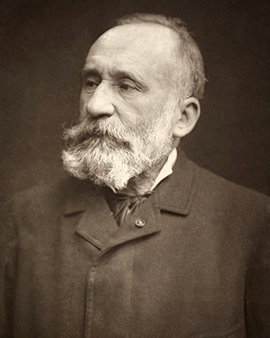Pierre Puvis de Chevannes is considered one of the most important French painters of the 19th century. Although he also produced some canvas paintings, he was especially famous for his extensive murals. Today he is often called "The painter of France" and is revered by many contemporaries. De Chevanne's style cannot be clearly assigned to one of the great art movements, which possibly earned him the admiration of many different artists, such as Georges Seurat, Paul Gauguin, Théophile Gautier or Charles Baudelaire. He found his way to painting via detours. Puvis de Chevannes actually planned to become a mining engineer, just like his father. But due to a serious illness he had to prematurely interrupt his studies in Paris. During his recuperation period, he undertook a trip to Italy, which opened his eyes. He returned to Paris and announced that he now wanted to become a painter. His studies began at Eugène Delacroix. When Delacroix had to close his studio for health reasons soon after, Puvis went to Henry Scheffer and later to Thomas Couture.
After his training, Puvis acquired a large studio and attended anatomy courses at the art academy on the side. His breakthrough came several years later. He repeatedly sent in works for the Paris Salon, which were always rejected. After 8 unsuccessful years, his paintings "Concordia" and "Bellum" were finally exhibited in 1861. In the years that followed, he received many government commissions and produced various murals for town halls and other government institutions throughout the country. One of his most important and largest commissions were the panel paintings for the Paris Pantheon. Although mural painting made him famous, he continued his easel work in such works as "Hope" and "The Dream". Puvis de Chevannes was president and co-founder of the Société Nationale des Beaux-Arts, which became the dominant art salon of the time. Since 1926, this society has awarded the Puvis de Chevannes Prize in honour of its founder.
Born as Pierre-Cécile Puvis he added the title de Chevannes only later. For his father came from this old Burgundian noble family. He scorned his birthplace Lyon, however, throughout his life and preferred to refer to his Burgundian roots. During his time in Montmartre, Puvis de Chevannes is said to have had an affair with Suzanne Valadon, who was his model and later became a respected artist herself. However, this liaison has never been clearly proven. His great love was the Romanian princess Marie Cantacuzène. The two were a couple for a total of 40 years, but only married after 38 years of relationship. Marie died in the summer of 1898, which plunged Puvis de Chevannes into such mourning that he also died only two months later.
×





_187_-_(MeisterDrucke-1023307).jpg)
_187_-_(MeisterDrucke-1023307).jpg)
.jpg)
.jpg)
.jpg)
.jpg)
_-_(MeisterDrucke-1657931).jpg)
_-_(MeisterDrucke-1657931).jpg)
_-_(MeisterDrucke-1657234).jpg)
_-_(MeisterDrucke-1657234).jpg)
.jpg)
.jpg)
_-_(MeisterDrucke-36654).jpg)
_-_(MeisterDrucke-36654).jpg)
_1881_Sun_15_-_(MeisterDrucke-1022134).jpg)
_1881_Sun_15_-_(MeisterDrucke-1022134).jpg)
.jpg)
.jpg)
.jpg)
.jpg)
_1864_Sun_285x226_m_Lyon_-_(MeisterDrucke-984524).jpg)
_1864_Sun_285x226_m_Lyon_-_(MeisterDrucke-984524).jpg)
.jpg)
.jpg)
.jpg)
.jpg)
.jpg)
.jpg)
.jpg)
.jpg)
.jpg)
.jpg)
.jpg)
.jpg)
.jpg)
.jpg)
.jpg)
.jpg)
.jpg)
.jpg)
.jpg)
.jpg)
.jpg)
.jpg)
.jpg)
.jpg)
_-_(MeisterDrucke-141721).jpg)
_-_(MeisterDrucke-141721).jpg)
.jpg)
.jpg)
.jpg)
.jpg)
_-_(MeisterDrucke-951305).jpg)
_-_(MeisterDrucke-951305).jpg)
.jpg)
.jpg)
_Children_in_-_(MeisterDrucke-961994).jpg)
_Children_in_-_(MeisterDrucke-961994).jpg)
.jpg)
.jpg)
_The_Beheading_of_Saint_John_the_Bapt_-_(MeisterDrucke-961990).jpg)
_The_Beheading_of_Saint_John_the_Bapt_-_(MeisterDrucke-961990).jpg)
.jpg)
.jpg)
.jpg)
.jpg)
.jpg)
.jpg)
.jpg)
.jpg)
.jpg)
.jpg)
.jpg)
.jpg)
.jpg)
.jpg)
_-_(MeisterDrucke-320817).jpg)
_-_(MeisterDrucke-320817).jpg)
.jpg)
.jpg)
_-_(MeisterDrucke-203903).jpg)
_-_(MeisterDrucke-203903).jpg)
.jpg)
.jpg)
_-_(MeisterDrucke-379635).jpg)
_-_(MeisterDrucke-379635).jpg)
 - (MeisterDrucke-118633).jpg)
 - (MeisterDrucke-118633).jpg)
 - (MeisterDrucke-155279).jpg)
 - (MeisterDrucke-155279).jpg)
.jpg)
.jpg)
.jpg)
.jpg)
.jpg)
.jpg)
.jpg)
.jpg)
 - (MeisterDrucke-70375).jpg)
 - (MeisterDrucke-70375).jpg)
.jpg)
.jpg)
.jpg)
.jpg)
.jpg)
.jpg)
.jpg)
.jpg)
.jpg)
.jpg)
.jpg)
.jpg)
.jpg)
.jpg)
.jpg)
.jpg)
.jpg)
.jpg)
.jpg)
.jpg)
.jpg)
.jpg)
.jpg)
.jpg)
.jpg)
.jpg)
_-_(MeisterDrucke-961836).jpg)
_-_(MeisterDrucke-961836).jpg)
.jpg)
.jpg)
.jpg)
.jpg)
.jpg)
.jpg)
.jpg)
.jpg)
.jpg)
.jpg)
.jpg)
.jpg)
.jpg)
.jpg)
.jpg)
.jpg)
.jpg)
.jpg)
.jpg)
.jpg)
.jpg)
.jpg)
.jpg)
.jpg)
.jpg)
.jpg)
.jpg)
.jpg)
_(painting)_-_(MeisterDrucke-1322585).jpg)
_(painting)_-_(MeisterDrucke-1322585).jpg)
.jpg)
.jpg)
.jpg)
.jpg)
.jpg)
.jpg)
.jpg)
.jpg)
.jpg)
.jpg)
 - (MeisterDrucke-90796).jpg)
 - (MeisterDrucke-90796).jpg)
.jpg)
.jpg)
.jpg)
.jpg)
.jpg)
.jpg)
_1896_Natio_-_(MeisterDrucke-1419126).jpg)
_1896_Natio_-_(MeisterDrucke-1419126).jpg)
_-_1869_-_-_(MeisterDrucke-1006985).jpg)
_-_1869_-_-_(MeisterDrucke-1006985).jpg)
_-_(MeisterDrucke-1081931).jpg)
_-_(MeisterDrucke-1081931).jpg)
_Photography_-_(MeisterDrucke-1325781).jpg)
_Photography_-_(MeisterDrucke-1325781).jpg)
_-_(MeisterDrucke-35737).jpg)
_-_(MeisterDrucke-35737).jpg)
.jpg)
.jpg)
_Summer_Oil_on_canvas_before_1873_Nat_-_(MeisterDrucke-961991).jpg)
_Summer_Oil_on_canvas_before_1873_Nat_-_(MeisterDrucke-961991).jpg)
 1882 - (MeisterDrucke-634988).jpg)
 1882 - (MeisterDrucke-634988).jpg)
.jpg)
.jpg)
.jpg)
.jpg)
.jpg)
.jpg)
.jpg)
.jpg)






